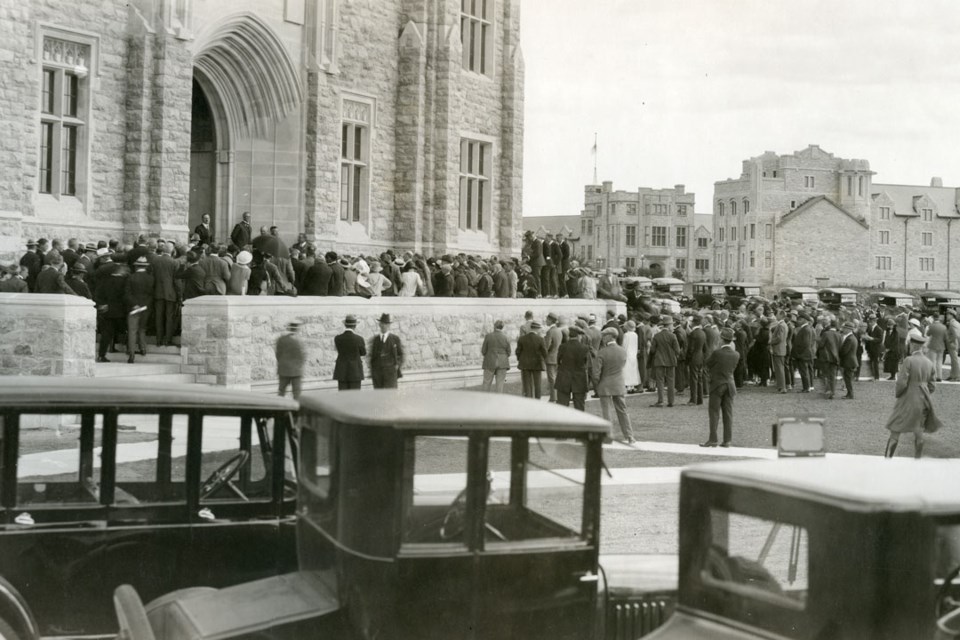SASKATOON — It’s the most iconic building on campus — and for good reason.
In August of 1924, Canadian dignitaries and scientists from across Canada and Britain gathered in Saskatoon for the official opening of an architectural marvel on the Prairies.
One hundred years later, the Thorvaldson Building on the University of Saskatchewan (USask) campus is still a wonder.
“It will always be somewhere that people look to as a sort of beacon of what education is supposed to be. It’s like a cathedral to higher learning,” said Dr. David Palmer (PhD), Thorvaldson professor of chemistry and former head of the Department of Chemistry, who has worked in the building for more than two decades.
The soaring and intricate structure reflects the optimism and prosperity of the era in which it was built.
“It represents the time period in Saskatchewan for me, the opulence and grandeur of it, of the Roaring Twenties,” said Saskatoon architect Megan Krueger (BA’09).
The Thorvaldson Building was one of the last buildings at USask designed by Montreal architect David Brown in the Collegiate Gothic style used for the first phase of campus construction. Built to evoke European churches and cathedrals of the Middle Ages, it resembles other early USask buildings but is set apart by its imposing scale, ornate details and rich materials.
“I see it as the culmination, the best example, the apex of the Collegiate Gothic period of architecture at the university,” said Saskatoon architect Andrew Wallace.
Wallace and Krueger, now principal architects at Wallace Klypak Architects Ltd., closely studied the Thorvaldson Building and other campus buildings as the authors of the 2013 .
Although originally named the Chemistry Building, the structure was built to house not just the Department of Chemistry but the College of Pharmacy, and College of Home Economics. Today, units including the Department of Computer Science, and the College of Graduate and Postdoctoral Studies, share the space.
The Thorvaldson Building—renamed in 1966 in honour of USask chemist Dr. Thorbergur Thorvaldson (PhD), the inventor of sulphate-resistant cement—has undergone extensive renovations and three major additions since it was built, but its original character remains intact.
The building’s stone exterior is in excellent condition, and many of the interior oak doors, classroom blackboards, metalwork features, and other elements are original. Where replacements of character-defining features of the building have been needed—such as the on the main staircase or the in the auditorium—exact replicas have been installed.
Spaces that have seen more change during the last century are the chemistry laboratories, which have had major updates to meet modern safety and performance standards. The original granite and porcelain laboratory sinks are long gone. Visitors no longer have to walk through a professor’s lab to reach their office.
Over the decades, the stories and people of the place have become part of the building’s character as much as its stones and tiles. This is the building where Thorvaldson spent years on his pioneering research, where Nobel Prize-winning chemist Dr. Henry Taube (PhD) studied, and where thousands of USask students learned the skills that launched their careers.
“It’s a bit of a testament to what architecture and great facilities can do when the facilities present the space and instruments and ability to practice these crafts,” said Krueger.
The Henry Taube Lecture Theatre—also known as the —is a particular magnet for . From the paper airplanes embedded in the ceiling to the room’s strange acoustics, everything about the Airplane Room sparks the imagination. The vast and scenic space simply inspires learning, said Palmer.
“Everyone who walks into that big lecture theatre appreciates education and what it’s for—and ideally, what it can bring everyone.”
The Thorvaldson Building was made to last.
“When that university campus was 小蓝视频 planned, (USask President) Walter Murray wrote in a letter to a friend, ‘remember that we are building for centuries,’” said Wallace. “They imagined these public buildings serving as the foundation of a society that was going to last hundreds of years and that these buildings would be in use for hundreds of years. And this one now has been.”
— Submitted by USask Media Relations




